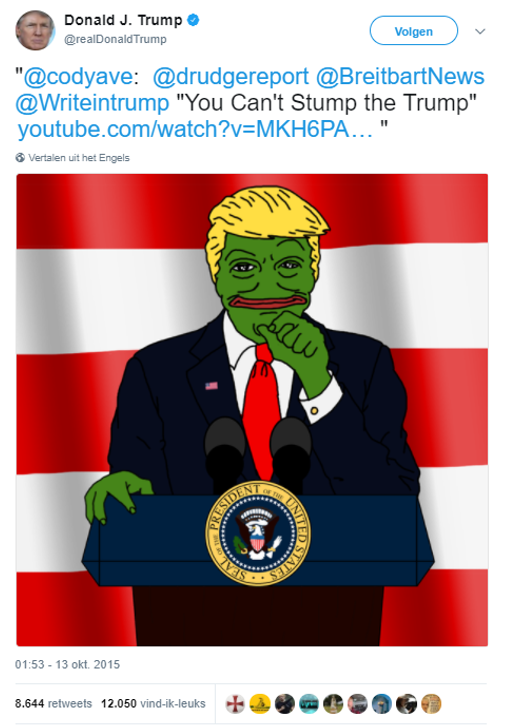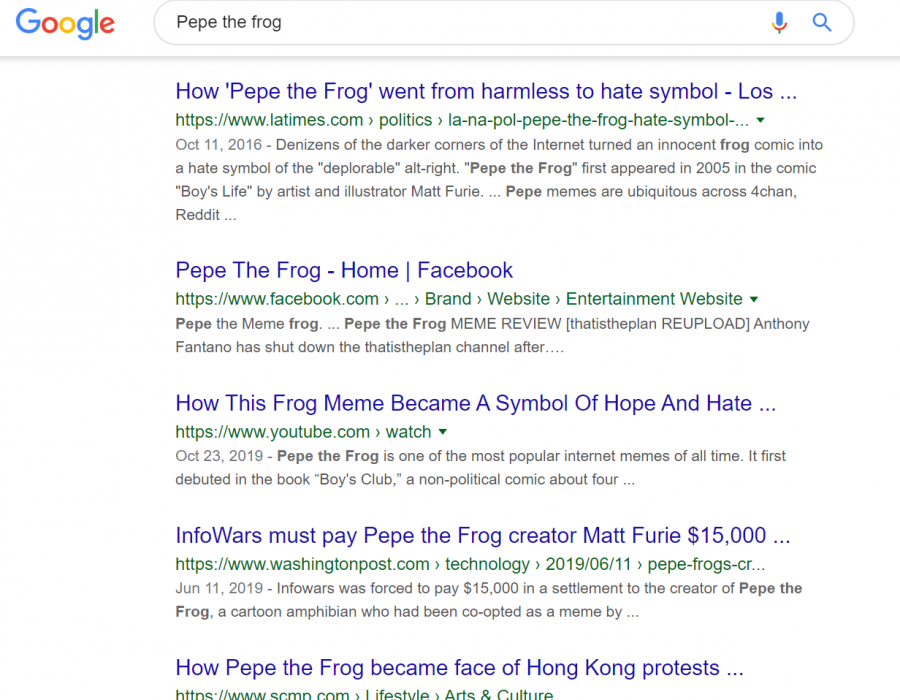
Amplifying the far-right: Reassessing the case of Pepe the Frog
A meme about a cartoon frog seems innocent enough, right? It might come as a shock, but this meme is a hate symbol now. Pepe the Frog started off as a funny and innocent meme, but he was appropriated by the extreme right group called the alt-right. How could such a small group change the meaning of a well-loved meme so drastically? In this article, I will analyse how the meaning of Pepe the Frog changed, how this meme went viral, and how digital media has played a fundamental role in a process like this.
A short introduction to Pepe
Pepe the Frog was created by Matt Furie in 2005, and initially appeared in a comic called Boy’s Club. Around 2008, one scene was taken out of the comic and was paired with the phrase "feels good man". This first version of the meme became popular on the /b/ board on 4chan.
In the next few years, many different versions of the Pepe meme started appearing on 4chan, but also on Instagram and Reddit. In 2014, celebrities like Katy Perry and Nicki Minaj posted variations of Pepe on their social media. This indicated that the meme had become mainstream. This was a big problem according to white nationalist @JaredTSwift, who gave an interview to Dailybeast. He said that if mainstream celebrities and traditional media get in on a meme, the meme is ruined. When a meme becomes more popular, it tends to get misused as people start using it in different ways than it was originally intended to be used. This is why a campaign was started to save the meme from so-called "normies", according to @JaredTSwift. Racist, anti-Semitic and Nazi versions of the meme were thus created to troll mainstream media and celebrities.
Another reason why these memes were created, was to stretch the Overton window for extreme right ideas. Most of these extreme versions were made and spread by the alt-right movement (short for "alternative right"). The alt-right is "a loosely organized far-right movement that emphasizes internet activism and is hostile to both multicultural liberalism and mainstream conservatism" (Lyons, 2017). The alt-right movement mostly acts online and they spread their ideas through videos, memes, blogs and forums (Morgan, 2017). The internet is really embedded in the definition of alt-right as it has helped facilitate the spread of their ideology (Valencia-García, 2017). Small online communities brought people together who had ideas that were not accepted by the wider public. In fact, stretching the window of ideas that are accepted as "normal" is one of the alt-right's goals, and a way they tried to achieve this was by claiming Pepe and using the meme as a carrier of their far-right discourse.
Because of the adaptable nature of memes, it is easy to plant a meme in any context you want.
When the alt-right took over Pepe the Frog, it became an official hate symbol. The Anti-Defamation League (ADL) added Pepe the Frog to their list of hate symbols. Still, they do mention that not all Pepe memes are inherently racist. Matt Furie tried to set up a campaign to save Pepe by spreading positive memes, but it eventually failed. In 2017, it was reported that Furie decided to kill Pepe because he felt that the alt-right had completely taken over the meme.
The meaning of memes
To fully understand why the meaning of this meme changed so drastically, we need to understand the nature and adaptability of memes. According to Varis and Blommaert (2015), a meme is a mixture of recognizability and individual creativity. Thus, a meme has to have a recognizable part and a part that individuals can change to make new versions of the meme. Oftentimes, a meme acquires a certain meaning as it has to be used in a certain way. In the old Pepe memes (before Pepe became associated with the alt-right), the image of the frog was often paired with the phrase "feels good man" and later with "feels bad man". Users could change small details, like the text or the background, to make their own versions. The meme had a specific meaning and a specific way of use. This is what makes a meme a meme; only the people who are familiar with it know its meaning.
However, the rules for a meme are not law, they are merely unwritten rules created by a community. Because of the adaptable nature of memes (Varis & Blommaert, 2015), it is easy to plant a meme in any context you want. Because of intertextuality, the entire meaning of the meme can then change. Every time we re-use language, we change its meaning slightly. When Pepe was put in a drastically different context by the alt-right, the meme's meaning also changed drastically. This meme was taken out of its original context and put into a completely new one. This caused that not only the racist and hateful Pepe’s were labelled as hate symbols, but the entire Pepe meme became a hate symbol because of its association with its use by the alt-right.
Pepe and Trump
Once the meaning of Pepe had changed, everybody who used the meme could be seen as a supporter of the alt-right. This is what happened when Donald Trump got involved with this meme.
On October 13, 2015, Trump tweeted this picture of him as Pepe. At this time, Pepe was already being used by the alt-right movement (Maly, 2018). This is how Trump got linked to the alt-right.

Trump as Pepe
We don’t really know the intention behind this post. He might have thought that it was just a funny picture. On the other hand, he might have strategically used it to get recognition from the alt-right. Many interpreted it as the latter.
The Hillary Clinton camp saw these posts as further proof that Trump is a racist and a white supremacist. After this post, an article was posted on Clinton's website about Pepe, which interpreted Trump's tweet as strengthening the connection between his campaign and the alt-right. The Clinton camp took this opportunity to put Trump in a bad light by framing him as part of this hateful group. This could have caused even more disapproval of Trump by Clinton supporters and left-wing voters.
At the same time, the alt-right movement saw Trump’s tweet as a sign of support. When Trump tweeted their symbol, it felt as recognition and support for their group. The reason why the tweet resonated so much with the alt-right could be explained through the concept of addressivity, which describes the fact that a message that is formulated a certain way or has a certain content, can speak to a specific audience. In the case of Trump, we see that he specifically tailored his message to the alt-right by using Pepe.
The alt-right also saw this as an opportunity to spread their ideology. They did not actually think that Trump would implement their ideas in politics, but Trump could help them to stretch the Overtone window (Lyons, 2017). Simply put, Trump gave the alt-right more exposure by spreading this meme. Exposure causes more discussion and can eventually cause the normalization of alt-right ideas.
Pepe and virality
The offensive and hateful versions of Pepe the Frog first spread in small online communities. Albright (2018) found that extreme right groups would often times gather in closed groups on Facebook instead of on open pages. He states that these closed groups are a big problem in the distribution of hateful content and memes.
As soon as the extremely offensive memes started spreading in public online places, the platforms themselves were quick to delete them. For example, Pepe memes featuring swastikas or Pepe’s that included the n-word violated the guidelines of many online platforms. You can still find them on the internet if you search for them, but you will probably not see them popping up on your Facebook feed. However, the damage had already been done. Many people had seen or heard about these extreme memes.
So, because of regulations against hate speech, the hateful memes themselves did not necessarily go viral. Still, the discussion surrounding the meme did. When searching about Pepe the Frog on Google, most of the results are about Pepe’s relation to the alt-right. Pictured below are just a few examples from Google’s first page, but many articles and videos like these fill up the Google search results.

Google search results
This is not the first time this has occurred with extreme right organizations. When a Google search lacks clear results, this is called a data void (Golebiewski & boyd, 2018). Extreme right organization can use certain SEO techniques to optimize their own websites and pages around these data voids. When you then search for a specific concept or term, mostly far right ideas will show up. The extreme right can thus use data voids to spread their own ideology. Something like this also indirectly happened with Pepe, whether it was intentional or not. The data void was not filled by the alt-right themselves, but by the media reporting on this discussion. This indirectly drew more attention to the alt-right and its ideology.
Pepe and the hybrid media system
Even though Pepe started off as an online meme, it also became a phenomenon in the offline media field. This generated even more attention for the meme and the alt-right. This was made possible due to the rise of the hybrid media system. The hybrid media system consists of the interactions between older and newer media. Newer media doesn’t replace older media, but instead the two become intertwined. The interactions between the media systems can lead to changes in the media field and the power relations in that field (Chadwick, Dennis & Smith, 2015)
Many offline news outlets also started reporting on Pepe and whether or not he was a hate symbol. Of course, due to the rise of the hybrid media system, many news outlets are not solely online or offline nowadays, but they operate in both systems, for example by having an online and a physical newspaper. This causes these outlets to also pay attention to what happens online. The online and offline media fields are not separated anymore, and thus online news will also be presented in offline media outlets. This was how the story of Pepe also reached offline media and did not solely stay online.
After the ADL officially added Pepe to their list of hate symbols, many news outlets started reporting on this. News outlets can face a dilemma when deciding to cover stories about extreme organizations. On the one hand, these stories are newsworthy and important to tell. If these topics are not discussed by journalists, there is a chance that they will get covered poorly by someone else (Phillips, 2018). On the other hand, journalistic coverage might amplify the story and bring more attention to it (Phillips, 2018). If news outlets decide to talk about Pepe and the alt-right, it might make the alt-right more visible and influential. At the same time, news outlets amplifying the story can help normalize the alt-right's views (Phillips, 2018).
If news outlets decide to talk about Pepe and the alt-right, it might make the alt-right more visible and influential.
In an example of journalistic coverage, CBS News posted a short clip to their YouTube channel in which they confirmed that Pepe was now a hate symbol. The YouTube channel of New York Daily News also posted a video about how the fastfood chain Wendy’s posted this hate symbol on their Twitter. News reports like this contribute to the idea that every Pepe meme is a hate symbol, even if some Pepe memes have no hateful characteristics. Supporting the idea that this meme is always a hate symbol might even give the alt-right more power. Even news stories that talk about Pepe from a neutral point of view might bring more attention to the alt-right, which can have negative consequences.
Media thus make it possible for small movements to gain more power. These changing power relations are a new phenomenon that came with the rise of the hybrid media system. Chadwick and colleagues (2015) state that the hybrid media system makes it easier for non-elites to gain more power. In this case, the alt-right is an non-elite organization that gained a lot of power by making a meme go viral in the hybrid media system. Even though the alt-right is a minority, they completely took over Pepe and this meme became a carrier of their discourse. Their influence became even bigger when online and offline news outlets started amplifying the story.
Reclaiming Pepe
So, is Pepe the Frog actually a hate symbol now? Yes and no. First of all, Pepe is not inherently racist or hateful and that was also not the intention of Pepe's creator. There are no characteristics of the original Pepe that could be described as hateful. In principle, this means that you are not a racist or a white supremacist when you post a regular Pepe meme. However, Pepe did get appropriated by the alt-right community. Because the meme was taken out of context and put in a new one, the meaning of the meme changed. Hence, many now see Pepe as a symbol for the extreme right. With the help of digital media and the hybrid media system, the idea that Pepe was a hate symbol was spread over all types of media. Because different types of media started to see Pepe as a hate symbol, it gave this idea more dominance.
But there is still hope for Pepe. There have been signs spotted that included Pepe in the recent protests in Hong Kong. There, Pepe is a symbol of hope that is mostly used by the protesting youth. As mentioned before, the meaning of a meme is defined by the way a meme is used. By putting Pepe in this new context, the meaning of the meme can change again. The Hong Kong protesters definitely have hope for Pepe. As a protester told the New York Times, “I think we can redefine Pepe in this movement”.

Pepe in Hong Kong protests
References
Albright, J. (2018). The Micro-propaganda Machine. Medium.
Chadwick, A., Dennis, J., & Smith, A. P. (2015). Politics in the age of hybrid media: Power, systems, and media logics. In The Routledge companion to social media and politics (pp. 7-22). Routledge.
Golebiewski, M., & boyd, d. (2018). Data voids: where missing data can easily be exploited. Data & Society, 29.
Lyons, M. N. (2017). Ctrl-alt-delete: The origins and ideology of the alternative right. Somerville, MA: Political Research Associates
Maly, I. (2018). Nieuw Rechts. Epo: Berchem.
Morgan, J. (2017). Alt right versus new right. Counter-Currents.
Phillips, W. (2018). The oxygen of amplification. Data & Society.
Valencia-García, L. D. (2017). The Rise of the European Far-Right in the Internet Age. EuropeNow (Council for European Studies at Columbia University).
Varis, P., & Blommaert, J. (2015). Conviviality and collectives on social media: Virality, memes, and new social structures. Multilingual Margins: A journal of multilingualism from the periphery, 2(1), 31-31.